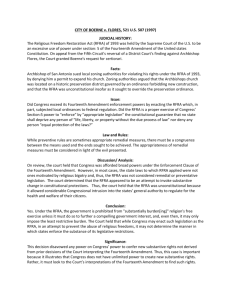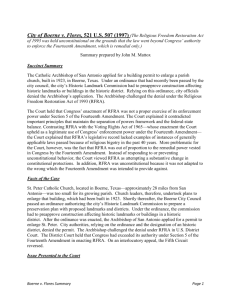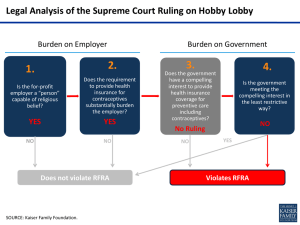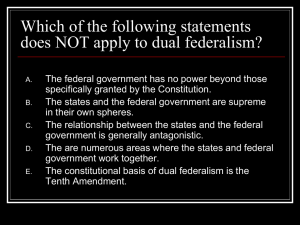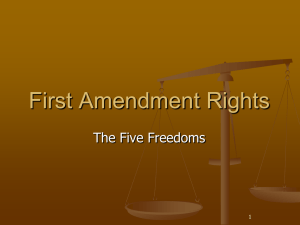Boerne v Flores
advertisement
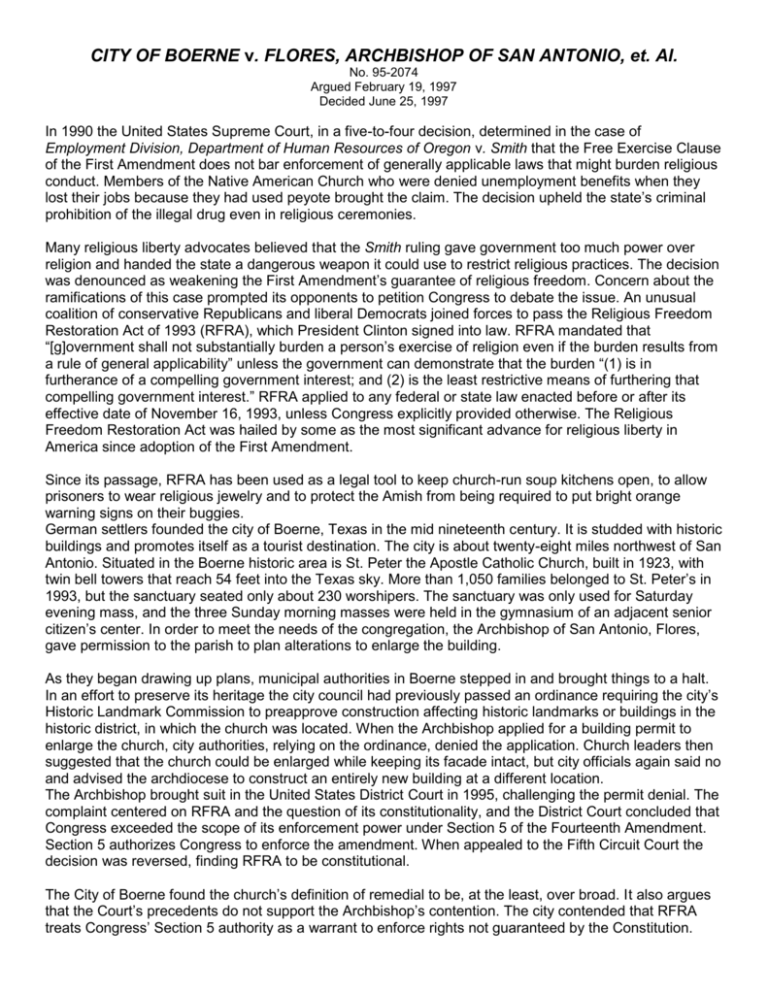
CITY OF BOERNE v. FLORES, ARCHBISHOP OF SAN ANTONIO, et. Al. No. 95-2074 Argued February 19, 1997 Decided June 25, 1997 In 1990 the United States Supreme Court, in a five-to-four decision, determined in the case of Employment Division, Department of Human Resources of Oregon v. Smith that the Free Exercise Clause of the First Amendment does not bar enforcement of generally applicable laws that might burden religious conduct. Members of the Native American Church who were denied unemployment benefits when they lost their jobs because they had used peyote brought the claim. The decision upheld the state’s criminal prohibition of the illegal drug even in religious ceremonies. Many religious liberty advocates believed that the Smith ruling gave government too much power over religion and handed the state a dangerous weapon it could use to restrict religious practices. The decision was denounced as weakening the First Amendment’s guarantee of religious freedom. Concern about the ramifications of this case prompted its opponents to petition Congress to debate the issue. An unusual coalition of conservative Republicans and liberal Democrats joined forces to pass the Religious Freedom Restoration Act of 1993 (RFRA), which President Clinton signed into law. RFRA mandated that “[g]overnment shall not substantially burden a person’s exercise of religion even if the burden results from a rule of general applicability” unless the government can demonstrate that the burden “(1) is in furtherance of a compelling government interest; and (2) is the least restrictive means of furthering that compelling government interest.” RFRA applied to any federal or state law enacted before or after its effective date of November 16, 1993, unless Congress explicitly provided otherwise. The Religious Freedom Restoration Act was hailed by some as the most significant advance for religious liberty in America since adoption of the First Amendment. Since its passage, RFRA has been used as a legal tool to keep church-run soup kitchens open, to allow prisoners to wear religious jewelry and to protect the Amish from being required to put bright orange warning signs on their buggies. German settlers founded the city of Boerne, Texas in the mid nineteenth century. It is studded with historic buildings and promotes itself as a tourist destination. The city is about twenty-eight miles northwest of San Antonio. Situated in the Boerne historic area is St. Peter the Apostle Catholic Church, built in 1923, with twin bell towers that reach 54 feet into the Texas sky. More than 1,050 families belonged to St. Peter’s in 1993, but the sanctuary seated only about 230 worshipers. The sanctuary was only used for Saturday evening mass, and the three Sunday morning masses were held in the gymnasium of an adjacent senior citizen’s center. In order to meet the needs of the congregation, the Archbishop of San Antonio, Flores, gave permission to the parish to plan alterations to enlarge the building. As they began drawing up plans, municipal authorities in Boerne stepped in and brought things to a halt. In an effort to preserve its heritage the city council had previously passed an ordinance requiring the city’s Historic Landmark Commission to preapprove construction affecting historic landmarks or buildings in the historic district, in which the church was located. When the Archbishop applied for a building permit to enlarge the church, city authorities, relying on the ordinance, denied the application. Church leaders then suggested that the church could be enlarged while keeping its facade intact, but city officials again said no and advised the archdiocese to construct an entirely new building at a different location. The Archbishop brought suit in the United States District Court in 1995, challenging the permit denial. The complaint centered on RFRA and the question of its constitutionality, and the District Court concluded that Congress exceeded the scope of its enforcement power under Section 5 of the Fourteenth Amendment. Section 5 authorizes Congress to enforce the amendment. When appealed to the Fifth Circuit Court the decision was reversed, finding RFRA to be constitutional. The City of Boerne found the church’s definition of remedial to be, at the least, over broad. It also argues that the Court’s precedents do not support the Archbishop’s contention. The city contended that RFRA treats Congress’ Section 5 authority as a warrant to enforce rights not guaranteed by the Constitution. Boerne cites the Court’s decision in Oregon v. Mitchell in 1970 as confirming the substantive authority in Congress and invalidating a Section 5 statute giving 18-year-old citizens the right to vote in state elections (it took the Twenty-sixth Amendment to do that). The City of Boerne quoted the late Chief Justice Warren Burger, “I have always read Oregon v. Mitchell as finally imposing a limitation on the extent to which Congress may substitute its own judgment for that of the states and assume this Court’s role of final arbiter....” The city argued that RFRA violates the constitutional separation of powers by allowing Congress to dictate how federal courts decide disputes between local and state governments and religious institutions. The city also argued that the Tenth Amendment guarantees that powers not delegated to the federal government are reserved by the states (federalism). They felt that RFRA violates the Tenth Amendment by restricting local and state government abilities to enforce local zoning measures and other laws. On this issue, the city cited the Court’s recent efforts in behalf of state sovereignty, New York v. United States, which determined that the federal government could not commandeer state legislative or administrative officers for federal purposed. In 1995, the Supreme Court found in United States v. Lopez that Congress’ attempt to interfere with the state on the subject of guns in a school zone was in violation of the Tenth Amendment. Flores argued that the First Amendment guarantees freedom of religion and the Fourteenth Amendment gives Congress broad powers to enforce First Amendment guarantees of liberty and equality. The Archbishop claimed that RFRA encourages governments to accommodate religious practices and that RFRA is a constitutional use of Congress’ power. Under RFRA, the burden of proof would be on the government to prove it has a “compelling” interest in impinging on religious freedom. The Archbishop reasoned that under RFRA the City of Boerne does not have a compelling interest in prohibiting the Archdiocese from demolishing St. Peter Church. Flores felt that Congress could dispense with Smith’s requirement of discriminatory intent as an element of a free exercise violation, mandating that laws such as the historic preservation ordinance at issue here that are neutral in intent and generally applicable to all properties within an affected area nonetheless require an extraordinary or compelling justification. The Archbishop observed that Congress took into consideration before passing RFRA the effects of the Smith decision on members of the Jewish, Mormon, and Amish faiths, among others. He also stressed testimony before Congress of how facially neutral laws can impose burdensome requirements on the individual exercise of religious belief. Congress, observed the Archbishop, also heard testimony about contemporary hostility between churches and secular interest groups, including use of zoning laws to exclude minority faiths. The Supreme Court’s decision to examine the Flores case was in itself a surprise. Normally the Court accepts cases when circuit courts have issued conflicting decisions, but regarding RFRA, three federal appellate courts, the Fifth, Seventh, and Washington, D.C. Circuit Courts had all previously declared the law to be constitutional. • ISSUE: Does the Religious Freedom Restoration Act violate the Tenth Amendment by restricting local and state governments’ abilities to enforce local zoning measures and other laws? Does RFRA violate the separation of powers doctrine, the First Amendment Establishment Clause, or the First Amendment Free Exercise Clause? BOERNE v. FLORES Decision The Supreme Court, in a six-to-three decision, struck down the 1993 Religious Freedom Restoration Act. Justice Kennedy wrote the majority opinion, which restored the 1990 Supreme Court decision in Oregon v. Smith. Kennedy explained that Congress had usurped the Court’s power to define constitutional protection of religion by passing RFRA. He wrote: Our national experience teaches that the Constitution is preserved best when each part of the government respects both the Constitution and the proper actions and determinations of the other branches. Writing in response to the argument that Congress has the power to pass RFRA under Section 5 of the Fourteenth Amendment, Kennedy responded: The design of the amendment and the text of [Section] 5 are inconsistent with the suggestion that Congress has the power to decree the substance of the Fourteenth Amendment’s restrictions on the States. Legislation which alters the meaning of the Free Exercise Clause cannot be said to be enforcing the Clause. Congress does not enforce a constitutional right by changing what the right is. It has been given the power “to enforce,” not the power to determine what constitutes a constitutional violation.... The Enforcement Clause ... did not authorize Congress to pass “general legislation upon the rights of the citizen, but corrective legislation; that is, such as may be necessary and proper for counteracting such laws as the States may adopt or enforce, and which, by the amendment, they are prohibited from making or enforcing.” Chief Justice Rehnquist and Associate Justices Stevens, Scalia, Thomas, and Ginsburg joined Kennedy. In a fierce dissent, Justice O’Connor took the extraordinary step of reading her objections from the bench, declaring that the majority’s ruling had harmed America’s religious liberty. She wrote: ... I agree with the Court that the issue before us is whether the religious Freedom Restoration Act (RFRA) is a proper exercise of Congress’ power to enforce Sections 5 of the Fourteenth Amendment. But as a yardstick for measuring the constitutionality of RFRA, the Court uses its holding in Employment Did., Dept. of Human Resources of Ore. v. Smith ..., the decision that prompted Congress to enact RFRA as a means of more rigorously enforcing the Free Exercise Clause. I remain of the view that Smith was wrongly decided, and I would use this case to re-examine the Court’s holding there.
